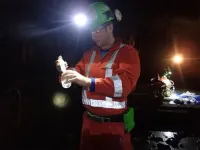What does 1.5 °C warming limit mean for China?
2021-04-22
(Press-News.org) As part of the Paris Agreement, nearly all countries agreed to take steps to limit the average increase in global surface temperature to less than 2 °C, or preferably 1.5 °C, compared with preindustrial levels. Since the Agreement was adopted, however, concerns about global warming suggest that countries should aim for the "preferable" warming limit of 1.5 °C.
What are the implications for China of trying to achieve this lower limit?
Prof. DUAN Hongbo from the University of Chinese Academy of Sciences and Prof. WANG Shouyang from the Academy of Mathematics and Systems Science of the Chinese Academy of Sciences, together with their collaborators, have attempted to answer this question.
Their results were published in an article entitled "Assessing China's efforts to pursue the 1.5°C warming limit," which was published in Science on April 22.
The authors used nine different integrated assessment models (IAMs) to make their evaluation of China's effort to achieve the warming limit of 1.5 °C.
The various models show different emission trajectories for carbon and noncarbon emissions. The majority of the IAMs will achieve near-zero or negative carbon emissions by around 2050, with a range from -0.13 billion tonnes of CO2 (GtCO2) to 2.34 GtCO2 across models. However, one highly consistent finding among all models is that the 1.5°C warming limit requires carbon emissions decrease sharply after 2020.
The researchers discovered that a steep and early drop in carbon emissions reduces dependency on negative emission technologies (NETs), i.e., technologies that capture and sequester carbon. One implication of this finding is that there is a trade-off between substantial early mitigation of carbon emissions and reliance on NETs, which may have uncertain performance. At the same time, the model showing the lowest carbon emissions by 2050 shows the greatest reliance on carbon capture and storage (CCS) technology--suggesting that NETs have an important role in reducing carbon emissions.
Although carbon emissions were an important focus of the study, the researchers also noted that reducing noncarbon emissions is necessary to stay under the warming limit. Specifically, carbon emissions must be reduced by 90%, CH4 emissions by about 71% and N2O emissions by about 52% to achieve the 1.5 °C goal.
The study showed that mitigation challenges differ across sectors, e.g., industry, residential and commercial, transportation, electricity and "other." Among these sectors, industry plays a big role in end-use energy consumption. Therefore, substantial changes in industrial energy use must occur to reach deep decarbonization of the entire economy and realization of the given climate goals. Indeed, a highly consistent finding across all models is that the largest proportion of emission reduction will come from a substantial decline in energy consumption.
The study also highlights the importance of replacing fossil fuels with renewables, a strategy that plays the next most important role in emission reduction behind reducing energy consumption. The study suggests that China needs to decrease its fossil energy consumption (as measured by standard coal equivalent, or Gtce) by about 74% in 2050 in comparison with the no policy scenario.
The researchers estimate that achieving the 1.5 °C goal will involve a loss of GDP in 2050 in the range of 2.3% to 10.9%, due to decreased energy consumption and other factors.
The study also noted that China's recently announced plan to become carbon neutral by 2060 largely accords with the 1.5 °C warming limit; however, achieving the latter goal is more challenging.
INFORMATION:
ELSE PRESS RELEASES FROM THIS DATE:
2021-04-22
LA JOLLA--(April 22, 2021) Spinal cord nerve cells branching through the body resemble trees with limbs fanning out in every direction. But this image can also be used to tell the story of how these neurons, their jobs becoming more specialized over time, arose through developmental and evolutionary history. Salk researchers have, for the first time, traced the development of spinal cord neurons using genetic signatures and revealed how different subtypes of the cells may have evolved and ultimately function to regulate our body movements.
The findings, published in ...
2021-04-22
In two landmark studies, researchers have used cutting-edge genomic tools to investigate the potential health effects of exposure to ionizing radiation, a known carcinogen, from the 1986 accident at the Chernobyl nuclear power plant in northern Ukraine. One study found no evidence that radiation exposure to parents resulted in new genetic changes being passed from parent to child. The second study documented the genetic changes in the tumors of people who developed thyroid cancer after being exposed as children or fetuses to the radiation released by the accident.
The findings, published around the ...
2021-04-22
Researchers have found that a natural molecule can effectively block the binding of a subset of human antibodies to SARS-CoV-2. The discovery may help explain why some COVID-19 patients can become severely ill despite having high levels of antibodies against the virus.
In their research, published in Science Advances today (22 April 2021), teams from the Francis Crick Institute, in collaboration with researchers at Imperial College London, Kings College London and UCL (University College London), found that biliverdin and bilirubin, natural molecules present in the body, can suppress the ...
2021-04-22
Researchers have identified another potential target for neutralizing antibodies on the SARS-CoV-2 Spike protein that is masked by metabolites in the blood. As a result of this masking, the target may be inaccessible to antibodies, because they must compete with metabolite molecules to bind to the otherwise open region, the study authors speculate. This competitive binding activity may represent another method of immune evasion by the SARS-CoV-2 virus. Although further validation work is needed, the findings suggest that strategies to unmask this region - thus making it more visible and accessible to antibodies - may help lead to new vaccine designs. ...
2021-04-22
AUSTIN, Texas -- Despite advances in medicine and technology, childbirth isn't likely to get much easier on women from a biological perspective.
Engineers at The University of Texas at Austin and University of Vienna revealed in new research a series of evolutionary trade-offs that have created a near-perfect balance between supporting childbirth and keeping organs intact on a day-to-day basis. Human reproduction is unique because of the comparatively tight fit between the birth canal and baby's head, and it is likely to stay that way because of these competing biological imperatives.
The size of the pelvic floor and canal is key to keeping this balance. These opposing duties have constrained the ability of the pelvic floor to evolve over time to make childbirth easier because doing ...
2021-04-22
Not all cancerous tumors are created equal. Some tumors, known as "hot" tumors, show signs of inflammation, which means they are infiltrated with T cells working to fight the cancer. Those tumors are easier to treat, as immunotherapy drugs can then amp up the immune response.
"Cold" tumors, on the other hand, have no T-cell infiltration, which means the immune system is not stepping in to help. With these tumors, immunotherapy is of little use.
It's the latter type of tumor that researchers Michael Knitz and radiation oncologist and University of Colorado Cancer Center member Sana Karam, MD, PhD, address in new research published this week in the Journal for ImmunoTherapy of Cancer. Working with mouse models in Karam's specialty area of head and neck cancers, Knitz and ...
2021-04-22
PROVIDENCE, R.I. [Brown University] -- As NASA's Perseverance rover begins its search for ancient life on the surface of Mars, a new study suggests that the Martian subsurface might be a good place to look for possible present-day life on the Red Planet.
The study, published in the journal Astrobiology, looked at the chemical composition of Martian meteorites -- rocks blasted off of the surface of Mars that eventually landed on Earth. The analysis determined that those rocks, if in consistent contact with water, would produce the chemical energy needed to support microbial communities similar to those that survive in the unlit depths of the Earth. Because these meteorites may be representative ...
2021-04-22
The unprecedented development of COVID-19 vaccines less than a year after discovery of this virus was enabled by more than $17 billion of research on vaccine technologies funded by the NIH prior to the pandemic, according to new research from Bentley University's Center for Integration of Science and Industry. The article, titled "NIH funding for vaccine readiness before the COVID-19 pandemic," demonstrates the critical role this broad foundation of government-funded research plays in ensuring vaccine readiness.
The report, published today in the journal Vaccine, ...
2021-04-22
DALLAS - April 22, 2021 - Being Black or Hispanic, living in high-poverty neighborhoods, and having Medicaid or no insurance coverage are associated with higher mortality in men and women under 40 with cancer, a review by UT Southwestern Medical Center researchers found.
"Survival is not different because of biology. It's not different because of patient-level factors," says Caitlin Murphy, Ph.D., lead author of the study and an assistant professor of population and data sciences and internal medicine at UT Southwestern. "No matter which way we looked at the data, we still saw consistent and alarming differences in survival by race - and these are teens and young adults."
Other findings based on an ...
2021-04-22
Machine learning could provide up an extra hour of warning time for debris flows along the Illgraben torrent in Switzerland, researchers report at the Seismological Society of America (SSA)'s 2021 Annual Meeting.
Debris flows are mixtures of water, sediment and rock that move rapidly down steep hills, triggered by heavy precipitation and often containing tens of thousands of cubic meters of material. Their destructive potential makes it important to have monitoring and warning systems in place to protect nearby people and infrastructure.
In her presentation at SSA, Ma?gorzata Chmiel of ETH Zürich described a machine learning approach to detecting and alerting against debris flows for the Illgraben torrent, a site in the European Alps that experiences significant debris flows and torrential ...
LAST 30 PRESS RELEASES:
[Press-News.org] What does 1.5 °C warming limit mean for China?




